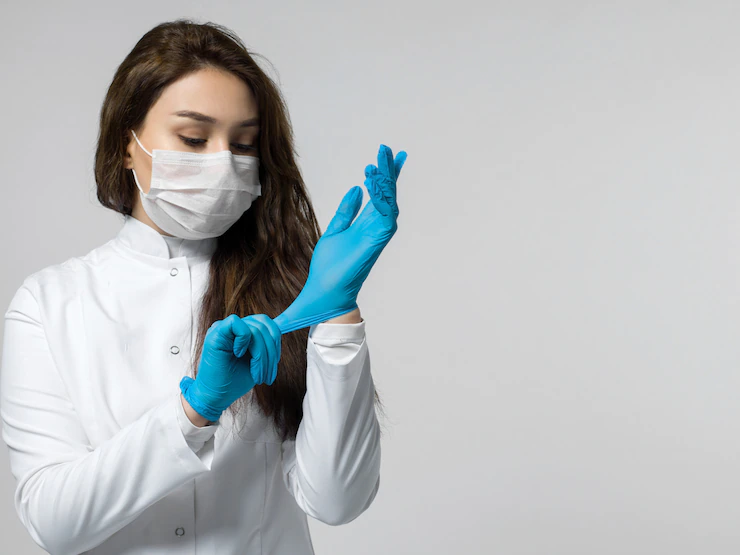Wearing gloves is a routine act in medical settings, and it is also important to wear sterile gloves to handle infectious materials such as blood, body fluids or tissues. Sterile gloves provide a physical and chemical barrier between the wearer’s skin and the contagious material outside the glove.
Wear surgical gloves before any medical procedure to reduce the risk of bacterial or viral infections. These gloves are made using surgical-grade latex or plastic, which give protection against microorganisms on skin coming into contact with infectious material outside of the glove over short periods.
What Is The Purpose Of Wearing Sterile Gloves?
The purpose of wearing sterile gloves is to prevent the transfer of bacteria from the wearer’s skin to the infected material. The sort of activity being performed, whether or not gloves need to be removed, and how long they will be required are all considerations that go into deciding whether or not a glove should be worn.
The primary purpose of wearing sterile gloves is to protect against infection. There are many other uses for gloves, including:
1. To Protect Wounds/Cuts/Sores On Hands And Arms
When cuts, wounds or sores are present on the hands and arms of health care workers, they must still perform their tasks. To protect against infection, they can wear gloves when they are not performing any task where direct contact with the wound is necessary.
2. To Prevent Harmful Objects From Coming Into Contact With Hands
The handles of potentially harmful objects such as scalpels and scissors should be wrapped in sterile tubes to prevent physical contact between the hands and instruments. The overmolding factories can help with the process.
3. To Prevent Infection Of Hands
There are some procedures where gloves are not required; however, can still be supported when performing these tasks to reduce the risk of infection further. These types of systems include:
- Skin swabbing: When skin swabbing is performed, the glove provides a layer between the skin and the swab, which reduces the number of bacteria transferred from one side to another.
- Emergencies: Gloves do not have to be removed when there is a problem during an operation or procedure. Due to the emergency nature of the situation, eliminating gloves would be more dangerous than wearing them.
Certain esports live streams can help the audience to know more about hazards.
4. To Prevent The Transfer Of Germs
Gloved hands are less likely to infect or spread infection than ungloved hands, and this is because gloves act as a barrier against microorganisms that can cause harm to the body when they are not adequately protected. The sterile gloves manufacturer also offers disposable medical gloves, sports gloves, food-processing gloves and other products at affordable prices.
5. To Create A Barrier Against Blood And Body Fluids
This is typically used with procedures where the person has to touch their blood, such as lab tests, rheumatology and neurosurgery. Wearing gloves when performing these tasks reduces the risk of spreading infection from the hands to the blood.
6. To Prevent Contamination Of Work Surfaces
Gloves are used by healthcare workers to protect themselves from infection and to protect the patient and other people’s health. Before touching a patient, gloves should be worn to ensure that the hands do not have any harmful agents. The hands should then be washed after the procedure is complete.
7. To Prevent The Spread Of Infection
Gloves can be worn when there is a possibility of spreading infection. This can occur if gloves are not worn immediately after any procedures involving touching the skin or in cases where too much time has passed since the process was done. When using disposable gloves, they are recommended to be discarded after each use to avoid spreading pathogens.
8. To Avoid Skin Contact With Dangerous Chemicals Or Liquids
Some substances, such as radio luminescent, are too dangerous to touch directly. A glove can be worn to hold such a substance and prevent harmful contact with the skin. When using a tape measure or other instrument, a glove can be worn to protect the joints and tendons from falling damage.
9. To Prevent Skin Burns
Burns on the skin are a common occurrence in health care settings. Gloves are worn to prevent the skin from being burned or damaged when handling light-sensitive chemicals or doing tasks like using a laser pointer or handheld torch. LED Neon flex is a new technology trend in the medical industry to promote medical products and services.
10. To Prevent Cuts And Abrasions
When operating with cutters, drills, saws and other sharp objects, gloves must be worn to reduce the risk of harm to the hands and arms. Gloves protect the hands from cuts and abrasions as opposed to an unprotected hand that can be cut by these tools and any debris left behind.
Conclusion
Gloves are a barrier between the bacteria found on the skin and infectious material. The gloves will determine how long they can be worn and how often they need to be replaced. Many different types of gloves are available, suited to various procedures; however, none can be worn indefinitely. Once contaminated with blood or body fluids, gloves should no longer be used. The type of glove preferred by health care workers varies depending on the procedure performed and the potential infection risk involved.


Would you like to share your thoughts?
Your email address will not be published. Required fields are marked *